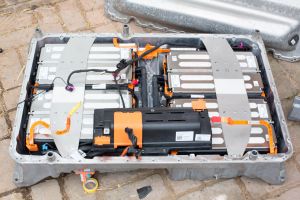Main Page: Difference between revisions
(Added some batteries/BMS) |
|||
| Line 34: | Line 34: | ||
|[[Tesla Model S/X Large Drive Unit ("LDU")|Large Drive Unit]] | |[[Tesla Model S/X Large Drive Unit ("LDU")|Large Drive Unit]] | ||
|Board Swap | |Board Swap | ||
| | |335-475 kW | ||
|- | |- | ||
| | | | ||
Revision as of 12:53, 4 September 2024
Did you know you can convert your existing fossil powered vehicle to use electricity instead? And that you can even produce that electricity yourself?
The openinverter project is mostly focused around converting ICE vehicles to battery electric by reusing existing components from production cars.
While the project, as the name suggests, started out as an open source implementation of a traction motor inverter it now comprises many other topics as well:
- Reusing complete drive trains
- Reusing batteries including the management electronics (BMS)
- Reusing on board chargers to charge your vehicle from AC outlets
- Reusing DC/DC converters to run your 12V system from the high voltage traction battery
- Reusing A/C compressors and cabin heaters
- Fast charging your vehicle on public rapid charging infrastructure
- Tying all components together with a vehicle control unit (VCU)
- Building small scale PV systems including storage
More on these topics in the detailed sections below. Happy reading!
Reusing motors and inverters - aka drive trains
The drive train is one of the defining building blocks of your conversion as it defines how well your vehicle picks up speed. Over the years we have reverse engineered many popular drive trains from production cars such as Teslas. As a bonus using such complete drive trains facilitates getting the vehicle road legal in many countries. By now you have a choice of low to medium power drive trains that only cost a few 100€ up to high performance ones at many 1000€.
We have established two methods of running these OEM systems: reverse-engineering their communication protocol and making the drive train "think" it is still in its original vehicle OR swapping out the control electronics for our own open source motor controller. The latter method gives your more control and power but also a steeper learning curve.
Nearly all drive trains are targeted at 400V battery voltage. Run at a lower voltage they will produce proportionally less power. Here is what we have done so far and how we've done it. Some is still work in progress (WIP)
| Manufacturer | Drive Train | Control Method | Approximate Power Output |
|---|---|---|---|
| Tesla | Large Drive Unit | Board Swap | 335-475 kW |
| Small Drive Unit | Board Swap | 180 kW | |
| Model 3/Y Rear Drive Unit | Board Swap/Board reprogramming [WIP] | 239 kW | |
| Model 3/Y Front Drive Unit | Board Swap/Board reprogramming [WIP] | 121 kW | |
| Nissan | Gen1 | CAN spoofing | 80 kW |
| Gen2 | CAN spoofing/Board Swap | 80 kW / 130 kW (board swap) | |
| Gen3 | CAN spoofing/Board Swap [WIP] | 110 - 160 kW | |
| Toyota | Lexus GS 450h | Communication spoofing | 250 kW |
| Lexus GS 300h | Communication spoofing | 105 kW | |
| Prius Gen2 | External Control Board | 40-70 kW | |
| Prius Gen3 | Board Swap/Communication spoofing | 100 kW | |
| MGR | Prius Gen2 or Gen3 inverter | 18-50 kW (various models) | |
| Mitsubishi | Rear Drive Unit | Communication spoofing | 60-70 kW |
| Front Drive Unit | Communication spoofing | 60-70 kW | |
| BMW | i3 | Board Swap | 125-135 kW |
| Chevy/Opel | Volt/Ampera | Board Swap | 160 kW |
| Ford | Ranger | Board Swap | Unknown |
| Renault | Zoe | Board Swap [WIP] | Unknown |
| MG | ZS EV | Board Swap [WIP] | Unknown |
Reusing Batteries
The most expensive and probably equally defining component is the battery that stores all the energy for running your car. Batteries are usually assembled from a number of modules that in turn contain a number of cells. Usually batteries are reused on a module level. In rare cases the battery can be reused as is in its original battery box.
While there are also various open source implementations of battery management systems (BMS) we generally recommend using as much of the OEM BMS as possible. Sometimes the OEM BMS comes as an all-in-one solution that measures cell data and spits out state of charge and power limit information. In other cases the BMS is split into module units that measure the physical data (voltages, temperatures) and a central unit that calculates the high level information.
Sometimes we managed to reuse the complete system which is generally the safest as you can rely on the manufacturers well tested charge and discharge limits as well as reliable state of charge information (i.e. how much energy is left in the battery at any given time). In other cases we only managed to reuse the module units. This adds the convenience of having a well tested piece of hardware with the matching connector but required us to calculate all high level battery data ourselves. This also incudes cell balancing.
| Manufacturer | Model | BMS usability | Energy Content |
|---|---|---|---|
| Tesla | Model 3 | Module and high level [WIP] | 60-80 kWh ? |
| Model S | Unknown | 85-100 kWh | |
| Nissan | Leaf/NV200 | High Level | 24-40 kWh |
| VW | Passat/Golf | Module Level | 8.7-36 kWh |


